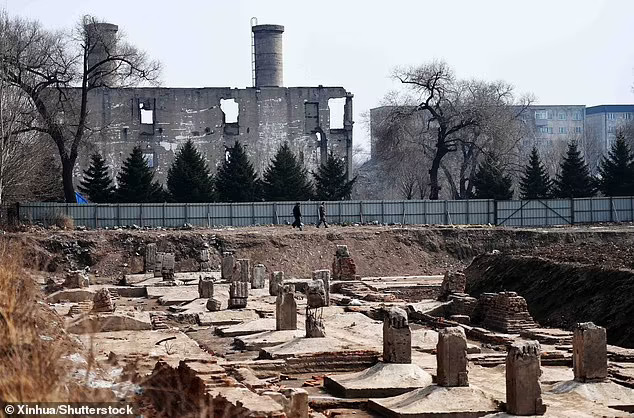
Foreign Property News | Posted by Zarni Kyaw
Concealed behind the high walls of a brick building in northeastern China, the horrors that went on in the Japanese Imperial army's Unit 731 remained a secret to the outside world for decades.
Codenamed the Kwantung Army's Epidemic Prevention and Water Purification Department, the facility was in fact a Japanese war camp that thousands of prisoners entered, but never left.
Inside, sadistic human experiments beyond most people's comprehension were carried out on inmates - treated as human guinea pigs for some of history's most depraved war crimes.
Innocent men, women and children were killed in the most savage ways imaginable - dissected alive, infected with deadly viruses, raped and used for target practice with flamethrowers and even 'plague bombs'.
Overseeing all of these unspeakable crimes was Unit 731's Dr Death - Shiro Ishii - a charismatic surgeon and ultra-nationalist fanatic who is considered the architect of the now notorious death camp's atrocities.

(A town called Ping Fan, 15 miles south of the regional capital Harbin, was selected as the site for Unit 731. picture shows: Ping Fan after it was blown up by the Japanese)

(Disturbing images show how Chinese civilians and allied POWs were dissected alive and infected with the plague)

(The effects of various remedies were tested on their frostbitten limbs)

(Shimizu was called to bury the burnt bones of murdered inmates in an effort to conceal the unit's crimes. Pictured: Digging at Unit 731)

(An aerial image shows the camp)
The army surgeon Ishii established the biological warfare research unit in 1936 to conduct research into germ warfare, weapons capabilities and the limits of the human body.
He did so with significant government funds and the blessing of Emperor Hirohito.
Ishii arrived in Manchuria, modern-day China, not long after the occupation forces.
A town called Ping Fan, 15 miles south of the regional capital Harbin, was selected as the site for Unit 731. In the surrounding town, the Japanese occupiers would not permit the construction of buildings high enough to glimpse the violence going on within the compound walls.
Once set up, military police began to hunt down victims for the unit's experiments - many of whom were Chinese civilians including children. The army also sent Russian, British and American POWs there. The inmates were deliberately kept healthy, fed on a diet of rice, meat, fish and even alcohol on occasion, so their bodies would be in good condition for the experiments to begin.

(A human 'subject', seemingly a young Chinese civilian, is subjected to an unknown form of bacteriological test at Unit 731)

(Wound of a plague patient during bacteriological test directed by Japan's Unit 731)
'If Ishii or one of his co-workers wished to do research on the human brain, then they would order the guards to find them a useful sample,' Sheldon Harris wrote in his book Factories of Death.
'A prisoner would be taken from his cell. Guards would hold him while another guard would smash the victim's head open with an ax. His brain would be extracted and rushed immediately to the laboratory.
'The body would then be whisked off to the pathologist, and then to the crematorium for the usual disposal.'
Vivisections were common practice, with former workers revealing what they saw - and even did themselves - decades later.
A former medical assistant at Unit 731, a farmer in his 70s who wanted to remain anonymous, told the New York Times in 1995 about the first time he cut open a live man.
'The fellow knew that it was over for him, and so he didn't struggle when they led him into the room and tied him down,' he said. 'But when I picked up the scalpel, that's when he began screaming.
'I cut him open from the chest to the stomach, and he screamed terribly, and his face was all twisted in agony. He made this unimaginable sound, he was screaming so horribly. But then finally he stopped. 'This was all in a day's work for the surgeons, but it really left an impression on me because it was my first time.'
 (The site of the Japanese Unit 731 in Harbin, which was opened to the public to mark the 70th anniversary of the end of World War II)
(The site of the Japanese Unit 731 in Harbin, which was opened to the public to mark the 70th anniversary of the end of World War II)
Germ warfare experiments were also a key part of Unit 731, with Ishii and his henchmen breeding lethal strains of viruses to wipe out the Chinese population. Enough germs were created to kill everyone on earth many times over, according to reports, with 300 kilos of plague bacteria were produced every month, 500 kilos of anthrax, and nearly a tonne of dysentery and cholera.
Children were fed chocolates laced with anthrax and biscuits infected with plague, while older inmates were given typhoid-infected dumplings and drinks. Thirty teenagers from Harbin died after being given typhoid-contaminated lemonade, according to a report in the Sydney Morning Herald.
Ref: Inside Japan's hellish 'Unit 731' where WW2 inmates were raped to infect them with syphilis, PoWs burnt alive in flamethrower practice and children given 'anthrax chocolates' in horrific human experiments overseen by 'Dr Death' (dailymail)
Photo Credit: dailymail









